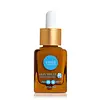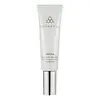What's inside
What's inside
 Key Ingredients
Key Ingredients

 Benefits
Benefits

 Concerns
Concerns

 Ingredients Side-by-side
Ingredients Side-by-side

Water
Skin ConditioningCaprylic/Capric Triglyceride
MaskingIsododecane
EmollientButylene Glycol
HumectantGlycerin
HumectantSqualane
EmollientPolysorbate 80
EmulsifyingPolyglyceryl-6 Behenate
Emulsion StabilisingPolyglyceryl-6 Stearate
EmollientDaucus Carota Sativa Seed Oil
EmollientGlyceryl Stearate
EmollientRetinol
Skin ConditioningPolysorbate 20
EmulsifyingPhenoxyethanol
PreservativeCaprylyl Glycol
EmollientSodium Polyacryloyldimethyl Taurate
Emulsion StabilisingSimmondsia Chinensis Seed Oil
EmollientAllantoin
Skin ConditioningDisodium EDTA
Inulin Lauryl Carbamate
Emulsion StabilisingSolanum Lycopersicum Fruit Extract
AntioxidantBehentrimonium Chloride
PreservativeSucrose Laurate
EmollientWater, Caprylic/Capric Triglyceride, Isododecane, Butylene Glycol, Glycerin, Squalane, Polysorbate 80, Polyglyceryl-6 Behenate, Polyglyceryl-6 Stearate, Daucus Carota Sativa Seed Oil, Glyceryl Stearate, Retinol, Polysorbate 20, Phenoxyethanol, Caprylyl Glycol, Sodium Polyacryloyldimethyl Taurate, Simmondsia Chinensis Seed Oil, Allantoin, Disodium EDTA, Inulin Lauryl Carbamate, Solanum Lycopersicum Fruit Extract, Behentrimonium Chloride, Sucrose Laurate
Water
Skin ConditioningPolysorbate 60
EmulsifyingLactic Acid
BufferingIsopropyl Myristate
EmollientGlyceryl Stearate
EmollientHamamelis Virginiana Water
AstringentStearic Acid
CleansingCetearyl Alcohol
EmollientGlycerin
HumectantSodium Hydroxide
BufferingLeuconostoc/Radish Root Ferment Filtrate
AntimicrobialTartaric Acid
BufferingRetinyl Acetate
Skin ConditioningAlbumen
Skin ConditioningCetyl Alcohol
EmollientBenzyl Alcohol
PerfumingMalic Acid
BufferingOlea Europaea Fruit Oil
MaskingRetinol
Skin ConditioningPichia/Resveratrol Ferment Extract
Skin ConditioningResveratrol Dimethyl Ether
AntioxidantGalactoarabinan
Proline
Skin ConditioningRetinyl Palmitate
Skin ConditioningCitrus Grandis Peel Oil
MaskingCananga Odorata Flower Oil
MaskingBisabolol
MaskingTocopheryl Acetate
AntioxidantAloe Barbadensis Leaf Juice Powder
Skin ConditioningAllantoin
Skin ConditioningDaucus Carota Sativa Root Extract
Skin ConditioningPrunus Amygdalus Dulcis Oil
Skin ConditioningHelianthus Annuus Seed Oil
EmollientChamomilla Recutita Flower Extract
MaskingTocopherol
AntioxidantAlthaea Officinalis Root Extract
Skin ConditioningAlcohol
AntimicrobialCitric Acid
BufferingPolysorbate 20
EmulsifyingPotassium Sorbate
PreservativeLimonene
PerfumingSodium Gluconate
Skin ConditioningBHA
AntioxidantBehenyl Alcohol
EmollientCaprylhydroxamic Acid
Alcohol Denat.
AntimicrobialBHT
AntioxidantXanthan Gum
EmulsifyingPhenoxyethanol
PreservativeWater, Polysorbate 60, Lactic Acid, Isopropyl Myristate, Glyceryl Stearate, Hamamelis Virginiana Water, Stearic Acid, Cetearyl Alcohol, Glycerin, Sodium Hydroxide, Leuconostoc/Radish Root Ferment Filtrate, Tartaric Acid, Retinyl Acetate, Albumen, Cetyl Alcohol, Benzyl Alcohol, Malic Acid, Olea Europaea Fruit Oil, Retinol, Pichia/Resveratrol Ferment Extract, Resveratrol Dimethyl Ether, Galactoarabinan, Proline, Retinyl Palmitate, Citrus Grandis Peel Oil, Cananga Odorata Flower Oil, Bisabolol, Tocopheryl Acetate, Aloe Barbadensis Leaf Juice Powder, Allantoin, Daucus Carota Sativa Root Extract, Prunus Amygdalus Dulcis Oil, Helianthus Annuus Seed Oil, Chamomilla Recutita Flower Extract, Tocopherol, Althaea Officinalis Root Extract, Alcohol, Citric Acid, Polysorbate 20, Potassium Sorbate, Limonene, Sodium Gluconate, BHA, Behenyl Alcohol, Caprylhydroxamic Acid, Alcohol Denat., BHT, Xanthan Gum, Phenoxyethanol
Ingredients Explained
These ingredients are found in both products.
Ingredients higher up in an ingredient list are typically present in a larger amount.
Allantoin is a soothing ingredient known for its protective and moisturizingg properties. Because of this, it is often added to products with strong active ingredients.
Studies show higher concentrations of this ingredient can promote wound healing.
Though it can be derived from the comfrey plant, allantoin is produced synthetically for cosmetic products to ensure purity.
Learn more about AllantoinGlycerin is already naturally found in your skin. It helps moisturize and protect your skin.
A study from 2016 found glycerin to be more effective as a humectant than AHAs and hyaluronic acid.
As a humectant, it helps the skin stay hydrated by pulling moisture to your skin. The low molecular weight of glycerin allows it to pull moisture into the deeper layers of your skin.
Hydrated skin improves your skin barrier; Your skin barrier helps protect against irritants and bacteria.
Glycerin has also been found to have antimicrobial and antiviral properties. Due to these properties, glycerin is often used in wound and burn treatments.
In cosmetics, glycerin is usually derived from plants such as soybean or palm. However, it can also be sourced from animals, such as tallow or animal fat.
This ingredient is organic, colorless, odorless, and non-toxic.
Glycerin is the name for this ingredient in American English. British English uses Glycerol/Glycerine.
Learn more about GlycerinGlyceryl Stearate is a mix of glycerin and stearic acid.
It is used to stabilize the mixing of water and oil ingredients. By preventing these ingredients from separating, it can help elongate shelf life. It can also help thicken the product's texture.
As an emollient, it helps soften skin and supports barrier-replenishing ingredients.
In cosmetics, Glyceryl Stearate is often made from vegetable oils or synthetically produced.
This ingredient may not be fungal-acne safe
Fun fact: The human body also creates Glyceryl Stearate naturally.
Learn more about Glyceryl StearatePhenoxyethanol is a preservative that has germicide, antimicrobial, and aromatic properties. Studies show that phenoxyethanol can prevent microbial growth. By itself, it has a scent that is similar to that of a rose.
It's often used in formulations along with Caprylyl Glycol to preserve the shelf life of products.
Polysorbate 20 is made by combining ethoxylation of sorbitan, ethylene oxide, and lauric acid. It is a mild cleansing agent, surfactant, and emulsifier.
As a surfactant, it helps collect dirt and oils for washing. Emulsifiers prevent oils and water from separating.
Polysorbate 20 also adds scent to a product. Since it is made using sorbitol, it has a sweet scent. Sorbitol can also be found in fruits such as apples and peaches.
The lauric acid used to create Polysorbate 20 is often derived from coconuts.
Polysorbate 20 may not be fungal acne safe.
Learn more about Polysorbate 20Retinol is a gold-standard ingredient for anti-aging. It is a form of Vitamin A and belongs to the class of retinoids that also includes tretinoin.
Why is retinol famous?
It has the most scientific studies backing up its skin benefits out of all the non-prescription ingredients.
Retinol is proven to:
This is why retinol is effective at removing wrinkles, fading dark spots, treating acne, and reducing the appearance of pores.
Studies show retinol is less effective when exposed to UV. Be sure to look for appropriate packaging to keep your retinol potent (similar to Vitamin C).
Using retinol or any retinoids will increase sun-sensitivity in the first few months. Though studies show retinoids increase your skin's natural SPF with continuous use, it is best to always wear sunscreen and sun-protection.
We recommend speaking with a medical professional about using this ingredient during pregnancy.
Retinol may cause irritation in some people, so be sure to patch test. Experts recommend 'ramping up' retinol use: start using this ingredient once a week and work up to using it daily.
Read about Tretinoin
Learn more about RetinolWater. It's the most common cosmetic ingredient of all. You'll usually see it at the top of ingredient lists, meaning that it makes up the largest part of the product.
So why is it so popular? Water most often acts as a solvent - this means that it helps dissolve other ingredients into the formulation.
You'll also recognize water as that liquid we all need to stay alive. If you see this, drink a glass of water. Stay hydrated!
Learn more about Water